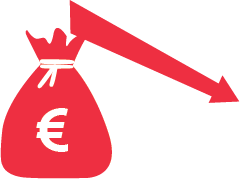ESG In Maritime Logistics: What Will 2022 Bring?
There are key premises to rethink the ESG perspectives in maritime logistics. The new "Amazon Effect", new agreements and rules from regulators, and a growing interest in supply chains efficiency from investors can significantly reshape the industry, bringing more transparency and accuracy to ESG metrics, benchmarking and strategy
The world's biggest companies, regulators and investors have turned their attention to the most pressing ESG issue – supply chains. This is one of the significant stumbling blocks for businesses committed to net zero emissions, for climate mitigation on the global level and for sustainable investments decision making. As a bottle neck of global supply chains, maritime logistics has become a source of new risks emerging for companies, investors and the planet in the coming decade. What are the key ESG-perspectives reshaping the maritime industry in the coming years?
At every moment a wide variety of goods crisscrosses global supply networks: shipping containers packed with consumer products; tankers full of oil, railcars carrying grain. These supply chains generate three-quarters of total CO2 emissions in pharmaceuticals, 92 percent in consumer goods and 98 percent in automotive, according to the CDP. And it is these top 3 industries using maritime logistics.
Large businesses have been a driving force for change at any time. And "Amazon Effect" when corporate business pushes corporates for net-zero supply chains, is only the latest example. As the world's biggest companies commit to going net-zero, downward emissions pressure may become as familiar to suppliers as downward price pressure.
In the latest Cargo Owners for Zero Emission Vessels (coZEV) initiative aimed at decarbonizing ocean shipping, nine major retailers and consumer companies, including Amazon, Ikea, Michelin, and Unilever, signed a pledge to switch all of their ocean freight to vessels powered by zero-carbon fuels by 2040. The signatories to the statement pointed to the need for a better understanding of their own maritime emissions. Working with fleet owners and shipping suppliers to reduce emissions by maximizing energy efficiency through operational and technical measures, the members of the coalition have profound plans to set up at least six green shipping corridors by the middle of the decade.
The critical aim of CoZev is to get 5% of the vessels to net zero by 2030, and set a pathway to net zero by 2050. The next years will show to what extend the coalition can push their market power on the suppliers that service them.
Large businesses have been a driving force for change at any time. And "Amazon Effect" when corporate business pushes corporates for net-zero supply chains, is only the latest example. As the world's biggest companies commit to going net-zero, downward emissions pressure may become as familiar to suppliers as downward price pressure.
In the latest Cargo Owners for Zero Emission Vessels (coZEV) initiative aimed at decarbonizing ocean shipping, nine major retailers and consumer companies, including Amazon, Ikea, Michelin, and Unilever, signed a pledge to switch all of their ocean freight to vessels powered by zero-carbon fuels by 2040. The signatories to the statement pointed to the need for a better understanding of their own maritime emissions. Working with fleet owners and shipping suppliers to reduce emissions by maximizing energy efficiency through operational and technical measures, the members of the coalition have profound plans to set up at least six green shipping corridors by the middle of the decade.
The critical aim of CoZev is to get 5% of the vessels to net zero by 2030, and set a pathway to net zero by 2050. The next years will show to what extend the coalition can push their market power on the suppliers that service them.
The New "Amazon Effect"
By 2022 we have reached 34 regulatory bodies and standard setters in 12 markets for ESG-reporting - TCFD, SFDR, NGFS etc. All of these climate-related disclosures are mostly focused on core corporate metrics, like greenhouse-gas emissions, and on some common parameters for climate-risk analysis. The main differences in climate-disclosure requirements are in uniformity of reporting and timing.
The maritime's environmental regulation is less mature than other transportation sub-segments. Global shipping's fragmentation, manual reporting processes along with the heavy debt burden and low margins, lead to the lack of credible data or even an absence of any ESG metrics for cargo owners – large and medium size business, logistic and insurance companies, sustainability strategy consultants.
Meanwhile, the IMO's GHG strategy for shipping requires the industry to reduce total annual GHG emissions by at least 50% by 2050. At the same time, the new rules* on corporate sustainability reporting (CSRD) have been agreed between the Council and the EU Parliament in June, 2022, and the German Supply Chain Due Diligence Act will enter into force in 2023. Tightening the screws regulators are forcing companies to search for innovative solutions that could help businesses to calculate CO2 in Scope 3, measure supply chains effectiveness and build tailored decarbonization plans.
As companies discover how much their suppliers emit, it could become a milestone for climate mitigation in supply chains. The main recommendation that we at Marine Digital can give any company – either it's a corporate business or fleet operators: to search for accurate and trusted sources of data, not averages, if you are interested to measure the entire impact of the business and build the sustainability strategy based in these analytics.
To learn more about the Marine Digital ESG Solution for monitoring maritime supply chains performance, high accuracy analytics of CO2 emissions, and advanced assessment of environmental and economic risks for business sustainability, please visit this page.
The maritime's environmental regulation is less mature than other transportation sub-segments. Global shipping's fragmentation, manual reporting processes along with the heavy debt burden and low margins, lead to the lack of credible data or even an absence of any ESG metrics for cargo owners – large and medium size business, logistic and insurance companies, sustainability strategy consultants.
Meanwhile, the IMO's GHG strategy for shipping requires the industry to reduce total annual GHG emissions by at least 50% by 2050. At the same time, the new rules* on corporate sustainability reporting (CSRD) have been agreed between the Council and the EU Parliament in June, 2022, and the German Supply Chain Due Diligence Act will enter into force in 2023. Tightening the screws regulators are forcing companies to search for innovative solutions that could help businesses to calculate CO2 in Scope 3, measure supply chains effectiveness and build tailored decarbonization plans.
As companies discover how much their suppliers emit, it could become a milestone for climate mitigation in supply chains. The main recommendation that we at Marine Digital can give any company – either it's a corporate business or fleet operators: to search for accurate and trusted sources of data, not averages, if you are interested to measure the entire impact of the business and build the sustainability strategy based in these analytics.
To learn more about the Marine Digital ESG Solution for monitoring maritime supply chains performance, high accuracy analytics of CO2 emissions, and advanced assessment of environmental and economic risks for business sustainability, please visit this page.
2022 As A Year Of Sustainability Reporting
Investors expect that ESG benchmarking can help them to cover the most critical questions – from whether a company is clean-handed in meeting its emission commitments to risks assessments of an investment strategy. But ESG ratings have fundamental flaws that make objective evaluation impossible. Methodology chaos, frequently changing criteria to achieve a good ESG rating; no adjustments in analytics for SME as they provide less data make the benchmarking insufficient for investments decisions.
A lack of consistency between rating providers' scores has been picked up as a key challenge for ESG ratings. It is quite often that a company's score differs significantly between ESG ratings providers. This has led to the flourishing of the analytical rigor that goes into ESG benchmarking to make it more relevant, high-profiled and industry-specified.
For instance, in maritime logistics we apply the Carbon Intensity Indicator (CII) as a consolidated KPI indicating a ship's operating energy efficiency performance in terms of CO2 emissions. This criteria ensures the transparent and accurate benchmarking and limits - from A to E. Carries and suppliers which use ships that fall into the category from D or E have a high exposure to finance, charter, and regulatory risks and penalties.
For cargo owners – large and SMEs – this benchmarking helps to indicate critical elements in their maritime supply chains and understand where to invest to decarbonize it. You can book a free demo to find out more about ESG rating for maritime logistics.
It is worth keeping in mind that generating an ESG score for supply chains or even for a company is a starting point; you get an indicator but not the whole story.
A growing need from investors for objectivity and credibility across the ESG benchmarking for companies and the particular business dimensions will enhance the requirements for methodologies and standardization. And it's definitely an exciting task for ESG rating providers and consultants as a strong and transparent rating system can help businesses to increase investment flows.
Read also New rules on corporate sustainability reporting
A lack of consistency between rating providers' scores has been picked up as a key challenge for ESG ratings. It is quite often that a company's score differs significantly between ESG ratings providers. This has led to the flourishing of the analytical rigor that goes into ESG benchmarking to make it more relevant, high-profiled and industry-specified.
For instance, in maritime logistics we apply the Carbon Intensity Indicator (CII) as a consolidated KPI indicating a ship's operating energy efficiency performance in terms of CO2 emissions. This criteria ensures the transparent and accurate benchmarking and limits - from A to E. Carries and suppliers which use ships that fall into the category from D or E have a high exposure to finance, charter, and regulatory risks and penalties.
For cargo owners – large and SMEs – this benchmarking helps to indicate critical elements in their maritime supply chains and understand where to invest to decarbonize it. You can book a free demo to find out more about ESG rating for maritime logistics.
It is worth keeping in mind that generating an ESG score for supply chains or even for a company is a starting point; you get an indicator but not the whole story.
A growing need from investors for objectivity and credibility across the ESG benchmarking for companies and the particular business dimensions will enhance the requirements for methodologies and standardization. And it's definitely an exciting task for ESG rating providers and consultants as a strong and transparent rating system can help businesses to increase investment flows.
Read also New rules on corporate sustainability reporting
Benchmarking Challenges For Investments Flows
ESG adviser, researcher - Elena Biryukova
Chief ESG officer. Lead business projects in PwC, Takeda, Aviva ReForum. Worked with the leading thinkers, scientists, researchers and entrepreneurs in various projects
Chief ESG officer. Lead business projects in PwC, Takeda, Aviva ReForum. Worked with the leading thinkers, scientists, researchers and entrepreneurs in various projects


TOP 5 factors contributing to lower fuel costs for Shipping companies
Get a presentation with a full description of the features and free pilot project with trial of Marine Digital FOS for 2 months
"Clicking the button, you consent to the processing of personal data and agree to the privacy policy"

Get an overview "The Pathway to Zero Carbon Shipping:
IMO Compliance and CII Optimization through SEEMP" on email and download it for FREE! Leave your email now!
"Clicking the button, you consent to the processing of personal data and agree to the privacy policy, as well as consent to subscribe to the newsletter. "
Аdvantage of Fuel Optimization System from Marine Digital:

Marine Digital FOS can be integrated with other system and third-party's solutions through the API. To implement vessel performance monitoring for any vessel, we are using mathematical algorithms, machine learning and the same equipment as in FOS. The more data we collect from vessels, the more precise reports and recommendations our system will perform according to your individual requirements in fleet management.
If you have any questions about the solutions and the Marine Digital System platform, write to us, we will be happy to answer
If you have any questions about the solutions and the Marine Digital System platform, write to us, we will be happy to answer

Increased business process speed

Reducing to zero the number of errors

Best offer to the clients

Reduction in operating expenses
Have a questions?





